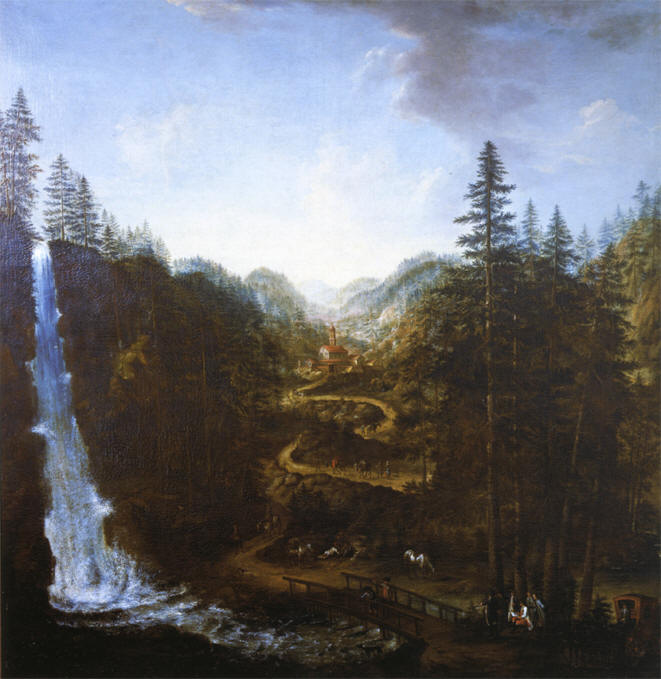
Simeon Goldmann, Prospectus of the Plezzo valley

Simeon Goldmann - Prospectus of the Plezzo valley, 1778
Oil on canvas, 169 x 190 cm. Gorizia, Foundation Savings Bank of Gorizia
On the back of a pasteboard sized with canvas:
«Veduta / della cataratta dell Rio d Utschea, Utscha bach in Tedesco, coll / Castello del Capitanato di Pletz, Flitsc detto, di Sua Maestà / Imperial Regia Apostolica della pertinenza della contea di Gorizia, dissegnato l'Anno 1756 di Sua Eccellenza Il signor Conte / Harrsch / Ministro Plenipotenziario alla Comissione de Confini, con la Serenissima Republica di Venezia./ Simeon Goldmann Pinxit, 1778».
These two canvases’ shows a cross section of the figurative reality within the area of prospectus and the landscape painting. They are showing the territory adjacent to the Venetian republic.
Simeon Goldmann — an artist, about whom we know very little, paints them on commission to a patrician family from Gorizia. He was active in Switzerland and Poland in seventeen hundred and eighties (Thieme, Becker, XIV, 1924, p. 341). The paintings are carried out from precise indications and surveys made by Ferdinando Filippo, count of Harsch. In the shape of minister under the Habsburgian crown he played a prominent part regarding the Austrian-Venetian commission who was to define the frontiers between the Republic of Venice and the Estate of Gorizia. The commission’s work started in 1750 and continued until 1756 and only the following year it was possible to put up the boundary posts. The engagement from Harsch in the solution of the delicate question about the territorial frontiers between the two powers, which had been insoluble since 1500, the year where the Estate of Gorizia had entered to make part of the inherited Habsburgian dominance, is exceptional pictured in the two canvas’ made by Simeon Goldmann.
The documentary intention is particularly clear in Veduta della conca di Plezzo, where it is possible to identify Ferdinando Filippo Harsh in the front group.
The recognition of the person is confirmed by the legend on the back of the canvas where it is explicitly told that the prospectus was carried out «l'anno 1756 d[a] Sua Eccellenza il Signor Conte Harsch». («in the year 1756 for his Excellency Sir Count Harsch».)
Annalia Delneri
Bibliography: Pavanello 1995, nn. 1-2; Delneri 2001, pp. 2-14 ; Porcedda 2001, pp. 15-23.